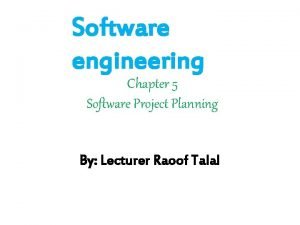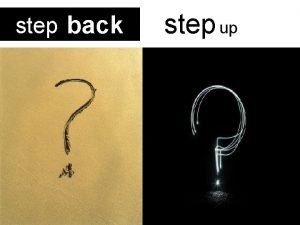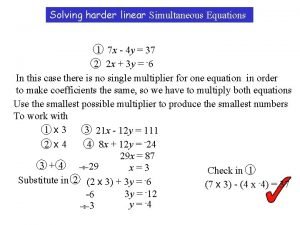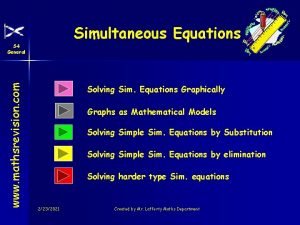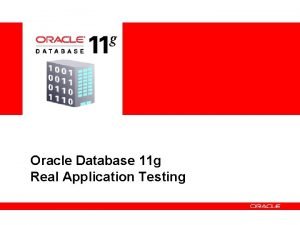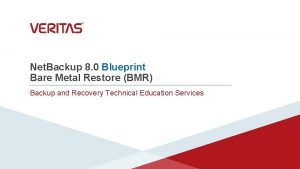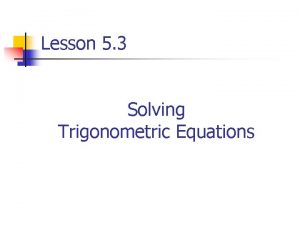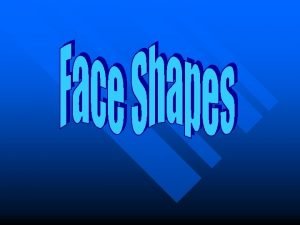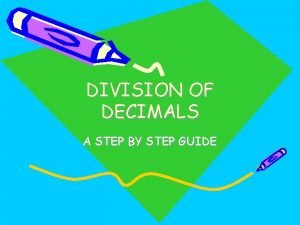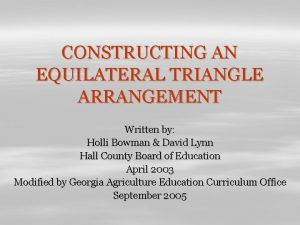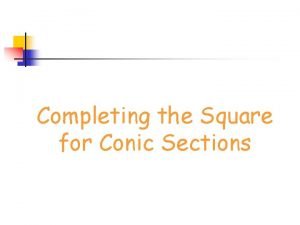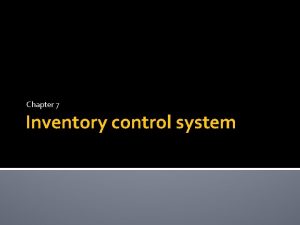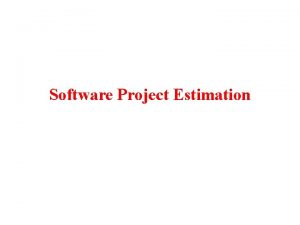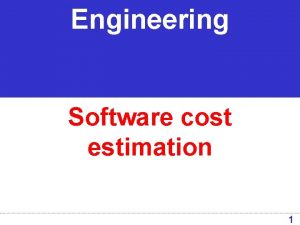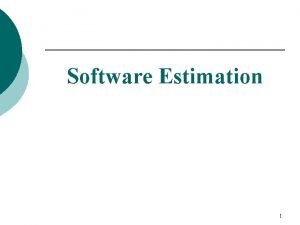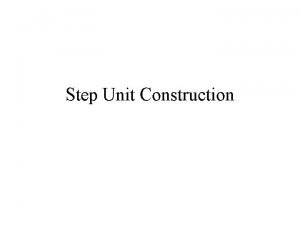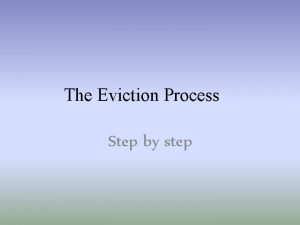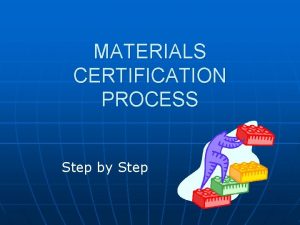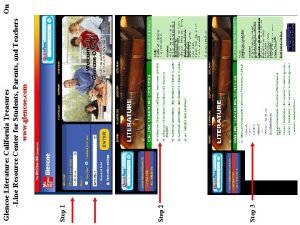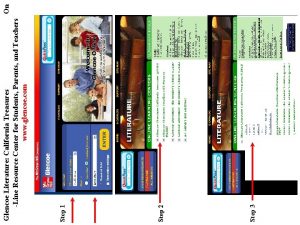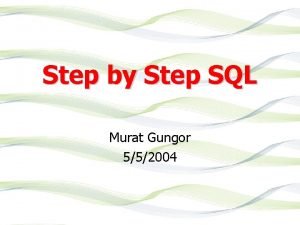Software Project Estimation First step in project estimation





























![• Expected value [4700 + (4 * 6000) + 10000] / 6 = • Expected value [4700 + (4 * 6000) + 10000] / 6 =](https://slidetodoc.com/presentation_image_h2/597224ef6bf7d3b495affb3a02cc8a7f/image-30.jpg)
- Slides: 30

Software Project Estimation

• First step in project estimation – is – Project Planning • 5 major activities performed in project planning

• Project Estimation – determine, scope of software product • Project Scheduling – determine, time required for each module & overall project • Risk Analysis – determine, problem complexity & risk • Quality Management Planning – determine, which quality metrics, are to be focused, while developing the software • Change Management Planning – if changes occur, how to handle them.

Software Scope & Feasibility • Software scope describes – four things – 1. The function & features, that are to be delivered to end users 2. The data – which can be input & output 3. The content of the software – that is presented to the user 4. Performance, constraints, reliability & interfaces that bound the system

• The scope can be defined – by 1. Using narrative description of the software, obtained after Having communication with the stakeholders. 2. defining, a set of use cases.

• After identifying scope of the project, its feasibility must be ensured. • Following are the four dimensions of software feasibility • Set of questions – based on these dimensions has to be answered

1. Technology - is the project technically feasible? - are the defects to be reduced, to a level that satisfies the applications need? 2. Finance - is it financially feasible? - is the development cost – affordable & according to standards? 3. Time - will project finish, within the given time? 4. Resource - does the organization have – the resources – needed to complete the project.

Resource Estimation • After, identifying scope & feasibility – of the project, • Estimate the resources, needed to complete the project • There are 3 major categories of – software engineering resources

• People - number - skill - location • Reusable software components - OTS (off-the-shelf) component - full experience component - part experience component - new component • Development environment i. e. hardware & software tools - hardware - network resources

• 4 characteristics of above mentioned resources • • Description of resource A statement of availability Time when resources will be required Duration of the time that resource will be applied

1. People (Human Resources) • Number & The organizational position - manager, senior software engineer, & so on • The skills - database, telecommunication, client/server, etc. • Location – • Are specified

2. Reusable Software Components • 4 categories of reusable software – 1. OTS (off-the-shelf) components - existing software acquired from a third party - or has been developed internally for a past project 2. full experience component – - the current software is same as the previous one - that was developed by the same working team 3. partial experience components 4. new components

3. Development Environment (Environmental Resources) • Software Engineering Environment (SEE) incorporates – hardware & software • Hardware - provides a platform - for using tools - required to produce work products • Software – - Are the tools, required - To produce implementation details - Testing & debugging

Decomposition

• Many times, in software engineering, - To solve the complex problem, it need to be Broken into – smaller sub problems & solving each sub problem – individually • This is referred as – - decomposition or partitioning

• Software sizing fuzzy logic sizing function point sizing standard component sizing change sizing • Problem based estimation • Example of LOC based estimation • Example of FP based estimation • Process based estimation • Example of process based estimation • Estimation with use cases • Reconciling estimates


1. Fuzzy logic sizing • In this approach, planner must identify – • The type of application • Establish its magnitude on qualitative scale • & then refine the magnitude within the original range • Planner should also have access to – historical database of the project • So that • Estimates can be composed to actual experiences.

2. Function Point Sizing • Planner develops estimates of the information domain

3. Standard Component Sizing • There are various standard components – used in the software • These are – - subsystems, modules, - screens, reports, - interactive programs, files, - LOC and Object-level instruction • The project planner – - Estimates – the number of time, these standard components are used. • He then uses, historical project’s data – - to determine the delivered size per standard component

4. Change sizing • This approach is used - When existing software – has to be modified - As per the requirement of - the project or user • The size of the software – is then estimated by - The number & type of reuse - Addition of code - change made in the code - deletion of code

Problem Based Estimation

Problem Based Estimation • Is conducted using – - LOC Based Estimation - Function Point Based Estimation - Process Based Estimation - Use Case Based Estimation

• LOC & FP based data are used in two ways, during software estimation 1. These are useful to estimate the - size – each element of software

• With a bounded statement of software scope, - A project planning process begins • & by using the statement of scope, - The software problem is decomposed into - The functions - That can be estimated individually. • LOC or FPs then estimated for each function


Example Of LOC Based Estimation • Consider an ABC project, with some important modules – such as – 1. user interface & control facilities 2. 2 D graphics analysis 3. 3 D graphics analysis 4. Database management 5. Computer graphics display facility 6. Peripheral control function 7. Design analysis models • Estimate the project – based on LOC

• Consider each module as separate function • The corresponding LOC can be estimated in the following table Function Estimated LOC User interface & control facilities 2500 2 D graphics analysis 5600 3 D graphics analysis 6450 Database management 3100 Computer graphics display facility 4740 Peripheral control function 2250 Design analysis models 7980 Total estimation in LOC 32620

• Expected LOC for 3 d Geometric Analysis function – three point estimation is – • Optimistic estimation - 4700 • most likely estimation - 6000 • Pessimistic estimation – 10000 • S = [Sopt + (4 * Sm) + Spess ] / 6
![Expected value 4700 4 6000 10000 6 • Expected value [4700 + (4 * 6000) + 10000] / 6 =](https://slidetodoc.com/presentation_image_h2/597224ef6bf7d3b495affb3a02cc8a7f/image-30.jpg)
• Expected value [4700 + (4 * 6000) + 10000] / 6 = 6450 A review of historical data indicates – 1. Average productivity is = 500 LOC/month 2. Average labor cost is = $6000/month Then cost for LOC can be estimated as – Cost/LOC = (6000/500) = $12/LOC By considering, total estimated LOC as = 32620 Total estimated project cost = (32620 * 12) = $391440 Total estimated project effort = (32620 / 500) = 65 Person-months
 Step 1 step 2 step 3 step 4
Step 1 step 2 step 3 step 4 Project planning software engineering
Project planning software engineering Buccal pit molar
Buccal pit molar Creating a dinosaur sculpture
Creating a dinosaur sculpture Steps to writing an informative essay
Steps to writing an informative essay How to write an argumentative essay step by step
How to write an argumentative essay step by step Step back step up
Step back step up How to factor equations
How to factor equations Harder simultaneous equations
Harder simultaneous equations Simultaneous equations step by step
Simultaneous equations step by step How to combine like terms step by step
How to combine like terms step by step The steps of photosynthesis
The steps of photosynthesis Bayes filter matlab
Bayes filter matlab Oracle real application testing
Oracle real application testing Bare metal restore netbackup
Bare metal restore netbackup Solve trig equations
Solve trig equations Naomi campbell face shape
Naomi campbell face shape Draw a punnett square of an ss x ss cross
Draw a punnett square of an ss x ss cross How to save viva video in gallery
How to save viva video in gallery How to install fusion compute
How to install fusion compute How to graph sine and cosine functions step by step
How to graph sine and cosine functions step by step Division
Division Paraffin test procedure
Paraffin test procedure Equilateral triangle floral arrangement
Equilateral triangle floral arrangement When to use complete the square
When to use complete the square Conics completing the square
Conics completing the square How to do chemical equations
How to do chemical equations Step-by step inventory process
Step-by step inventory process Kesler science balancing chemical equations
Kesler science balancing chemical equations Steps of blood flow through the heart
Steps of blood flow through the heart Chapter 15 musculoskeletal system
Chapter 15 musculoskeletal system

